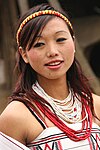Khiamniungan people
This article includes a list of general references, but it lacks sufficient corresponding inline citations. (August 2023) |
| Total population | |
|---|---|
| 120,000 approx. in Myanmar and 61,647 (2011), Nagaland[1] | |
| Languages | |
| 1 Patsho Khiamniungan 2 Khiamniungan language | |
| Religion | |
| Approximately 99%[citation needed] Christianity and 1% Animism | |
| Related ethnic groups | |
| Naga people |
The Khiamniungans are a Naga ethnic group, with approximately 35% of the population inhabiting in Noklak District in the Northeast Indian state of Nagaland and the rest in the Naga Self-Administered Zone and Hkamti District of Myanmar.[2] They were also called Kalyo-Kengnyu ("slate-house dwellers") during the British Raj.[3]
History
[edit]The origin of the Khiamniungans remains uncertain but the earliest consideration that generally traces back to a place called Khiamnyunga. There are no written records of their history before the British Raj days. However, the only source of information about their ancestors are oral traditions in the form of folktales and myths.
According to a popular myth, Khiamniungan means "source of great waters" - the place from where the early ancestors of Khiamniungan are said to have originated. This place is identified near Lingnyu-Tshüvau villages, under Patsho Range, overlooking from the present-day Patsho and Noklak towns.[4]
Today, the Khiamniungans occupy the easternmost part of India and northwestern part of Myanmar. In India, they are mostly found in Noklak district of Nagaland state and the rest in Naga Self Administered Zone and Hkhamti district of Saigaing Division, Myanmar. The mighty Chindwin river flows through the land of Khiamniungans.They are linked linguistically as well as culturally to the Tibeto-Burman.[5]
During the British Raj, the Khiamniungans were referred to as "kalyo Kenyu", particularly in the works of anthropologists such as Christoph von Fürer-Haimendorf. Unlike several other Naga people, the advent of Christianity had little impact on the Khiamniungan for a long time, due to their remote location. The first Khiamniungan to convert to Christianity was Khaming, in 1947.[6] Thereafter, a number of Khiamniungans converted to Christianity. After the coming of the new education system, social system, modernization and Christianity, there have been drastic changes in their social life.
Society of the ethnic group
[edit]The traditional Khiamniungan village had eight important people:[7]
- Nokpao (war leader)
- Petche or Pütshi (peace maker, elder)
- Ampau, Meyo, meya (priest)
- Muoli-ie (doctor)
- Ie or Ain (priestess and oracle)
- Shualang or sonlang (blacksmith)
- paothai or pautheu (story teller)
- Ainloom (the keeper of the a supposedly magical stone; the stone is said to warn of any impending disaster such as a fire or a raid, by moving out of its basket or by creating a sound through striking another object)
By the early 1990s, only the Petche, the Sonlang and the Ainloom remained relevant, others being remembered mainly as part of books and oral tradition.[7]
Culture
[edit]The traditional Khiamniungan attires consist of bright red and bright deep blue colored dresses. The ornaments are made of cowries and conch shells..[8]
The ethnic musical instruments include drums made of gourds and bamboo flutes.
Language
[edit]Most of the Khiamniungans in India are acquainted with Patsho Khiamniungan which is also one of the main languages within their geographical region.[9]
Festivals
[edit]Miu
[edit]The Khiamniungan people, who traditionally practised jhum cultivation (slash and burn agriculture), celebrate the Miu festival at the time of sowing. They offer prayers for a good harvest.[10]
Tsoukum
[edit]Tsoukum is the week-long harvest festival of the ethnic group, celebrated in October. The festival includes dancing, singing, cleaning, repair of the roads, and outdoor cooking and eating. In this festival the people invoke god's blessing for a bountiful harvest.[11]
Seisei-ie
[edit]A wordplay or pun is one of the unique cultures of the Khiamniungans since the inception of the villages. Traditionally it was played between villages in the form of competition unlike today's norm of performing for entertainment purposes.[12]
References
[edit]- ^ "CENSUS OF ST". CENSUS INDIA. MHA GOI.
- ^ Ved Prakash (2007). Encyclopaedia Of North-east India Vol# 5. Atlantic. pp. 2137–2139. ISBN 978-81-269-0707-6.
- ^ Hamlet Bareh, ed. (2001). Encyclopaedia of North-East India: Nagaland (Volume 6). Mittal. p. 259. ISBN 978-81-7099-787-0.
- ^ THE LAND OF CULTURE TUENSANG "KHIAMNIUNGAN TRIBE"
- ^ "NAGAS IN MYANMAR: PEOPLE OF THE FORGOTTEN LAND - The Morung Express". morungexpress.com. 21 January 2024.
- ^ Albie Sachs; Geeti Sen (2001). "The Making of a Freedom Fighter". India International Centre Quarterly. 28. India International Centre: 99.
- ^ a b Sushil K. Pillai. "Anatomy of an Insurgency: Ethnicity & Identity in Nagaland". SATP. Retrieved 24 October 2011.
- ^ "Nagaland Traditional Dress - Infinity Learn". infinitylearn.com. 21 January 2024.
- ^ "From oral tradition to written language - The Patsho Khiamniungan and Mongsen Ao dictionary projects - THE GLOBAL COUNCIL FOR ANTHROPOLOGICAL LINGUISTICS". glocal.soas.ac.uk. 21 January 2024.
- ^ "MIU & TSOKUM - KHIAMNIUNGAN TRIBE - Government of Nagaland - Department of information and public relation". nagaland.gov.in. 21 January 2024.
- ^ "Noklak: Khiamniungan tribe celebrates Tsokum festival - Nagaland Tribune". nagalandtribune.in. 21 January 2024.
- ^ "Yesterday's lifestyle today's identity Sanglau community celebrates culture and traditions-Nagaland Tribune". nagalandtribune.in. 21 January 2024.
